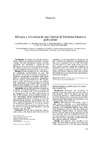Identificador persistente para citar o vincular este elemento:
https://accedacris.ulpgc.es/handle/10553/74306
| Campo DC | Valor | idioma |
|---|---|---|
| dc.contributor.author | García Lizana, F. | en_US |
| dc.contributor.author | Manzano Alonso, J. L. | en_US |
| dc.contributor.author | Treviño Peña, E. | en_US |
| dc.contributor.author | Pérez Ortiz, C. | en_US |
| dc.contributor.author | García Oliva, I. | en_US |
| dc.contributor.author | Vallejo Báez, A. | en_US |
| dc.contributor.author | Saavedra Santana, Pedro | en_US |
| dc.date.accessioned | 2020-09-09T09:55:29Z | - |
| dc.date.available | 2020-09-09T09:55:29Z | - |
| dc.date.issued | 2000 | en_US |
| dc.identifier.issn | 0210-5691 | en_US |
| dc.identifier.other | Scopus | - |
| dc.identifier.uri | https://accedacris.ulpgc.es/handle/10553/74306 | - |
| dc.description.abstract | Background. Physicians are constantly requested to improve health' care and the costs of their therapies. That is the reason why we need to know our results (in terms of death and quality of life (QOL) and the resources consumed for improving the effectiveness and efficiency of our Intensive Care Units in a future. Method. Retrospective descriptive study of 1000 patients, admitted to a multidisciplinary ICU. We excluded people younger than 15 years, foreigners and readmitted patients. Data regarding demography, previous diseases, diagnoses at admission, organic failure, ICU survival, hospital and one year later survival, previous and one year later QOL (with the modified EuroQOL) and the costs related to the length of stay in the hospital and ICU were collected. Kruskall-Wallis test was used for numerical variables. Results. 843 patients were included in the study. 212 (25%) died in the unit, 64 (7.5%) died in the hospital and 64 (7.5%) during the following year. From the total of 503 one year surviving patients, 58% showed a good health status, 30% suffered some discapacity but they live in a independent way and only the 11% had severe discapacities. The patients whose costs were lower were those that completely improved 23% of the patients consumed the 70% of global resources, and those were the patients that died or remained with the worst QOL. Conclusion. 60% of the patients survived one year later, and 89% of them with a good QOL, a fact which shows the ICU effectiveness and justified their existence. The patients who died or remained with a more limited QOL consumed the highest proportion of resources. Only if our predictive capacity of mortality and QOL becomes correct in 100% of cases we would be able to limit the treatments, and we shall improve the effectiveness. Meanwhile, only the Society can determine the distribution and contention of costs. | en_US |
| dc.language | spa | en_US |
| dc.relation.ispartof | Medicina Intensiva | en_US |
| dc.source | Medicina Intensiva [ISSN 0210-5691], v. 24 (5), p. 211-219, (Enero 2000) | en_US |
| dc.subject | 3212 Salud pública | en_US |
| dc.subject.other | Intensive Care | en_US |
| dc.subject.other | Quality Of Life Costs | en_US |
| dc.subject.other | Withholding And Withdrawing Life-Sustaining Therapy | en_US |
| dc.subject.other | Calidad de vida | en_US |
| dc.subject.other | Costes | en_US |
| dc.subject.other | Limitación y retirada de soporte vital | en_US |
| dc.subject.other | Medicina intensiva | en_US |
| dc.title | Eficacia y eficiencia de una Unidad de Medicina Intensiva polivalente | en_US |
| dc.title.alternative | Effectiveness and efficiency in a multidisciplinary ICU | en_US |
| dc.type | info:eu-repo/semantics/Article | en_US |
| dc.type | Article | en_US |
| dc.identifier.scopus | 0033913279 | - |
| dc.contributor.authorscopusid | 8315823200 | - |
| dc.contributor.authorscopusid | 6603719902 | - |
| dc.contributor.authorscopusid | 6506338106 | - |
| dc.contributor.authorscopusid | 6506615656 | - |
| dc.contributor.authorscopusid | 6506566377 | - |
| dc.contributor.authorscopusid | 7801338722 | - |
| dc.contributor.authorscopusid | 56677724200 | - |
| dc.description.lastpage | 219 | en_US |
| dc.identifier.issue | 5 | - |
| dc.description.firstpage | 211 | en_US |
| dc.relation.volume | 24 | en_US |
| dc.investigacion | Ciencias de la Salud | en_US |
| dc.type2 | Artículo | en_US |
| dc.utils.revision | Sí | en_US |
| dc.date.coverdate | Enero 2000 | en_US |
| dc.identifier.ulpgc | Sí | en_US |
| dc.contributor.buulpgc | BU-MED | en_US |
| dc.description.scie | SCIE | |
| item.fulltext | Con texto completo | - |
| item.grantfulltext | open | - |
| crisitem.author.dept | Departamento de Matemáticas | - |
| crisitem.author.orcid | 0000-0003-1681-7165 | - |
| crisitem.author.fullName | Saavedra Santana, Pedro | - |
| Colección: | Artículos | |
Citas SCOPUSTM
4
actualizado el 08-jun-2025
Visitas
105
actualizado el 20-jul-2024
Descargas
340
actualizado el 20-jul-2024
Google ScholarTM
Verifica
Comparte
Exporta metadatos
Los elementos en ULPGC accedaCRIS están protegidos por derechos de autor con todos los derechos reservados, a menos que se indique lo contrario.
